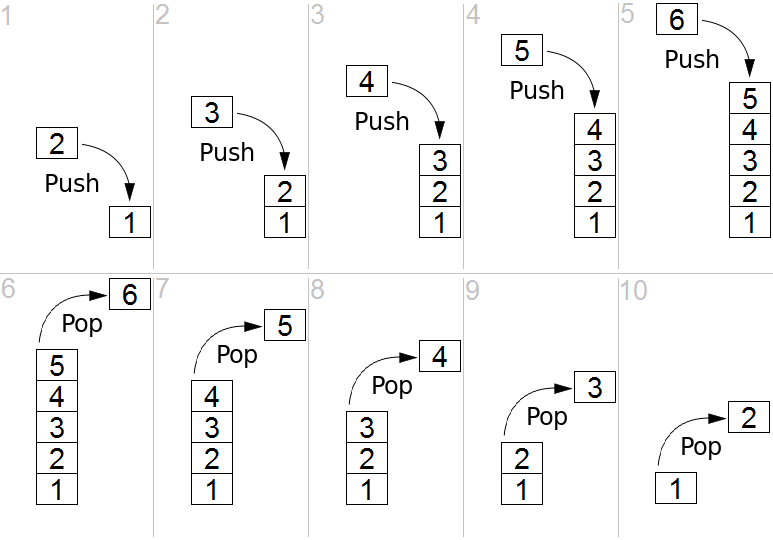Stack Implementation in C
A stack is a linear data structure that serves as a collection of elements, with three main operations.
- Push operation, which adds an element to the stack.
- Pop operation, which removes the most recently added element that was not yet removed, and
- Peek operation, which returns the top element without modifying the stack.
The push and pop operations occur only at one end of the structure, referred to as the top of the stack. The order in which elements come off a stack gives rise to its alternative name, LIFO (for Last–In, First–Out).
Following is a simple representation of a stack with push and pop operations:
A stack may be implemented to have a bounded capacity. If the stack is full and does not contain enough space for push operation, then the stack is considered in an overflow state.
Stack Implementation using an array:
A (bounded) stack can be easily implemented using an array. The first element of the stack (i.e., bottom-most element) is stored at the 0'th index in the array (assuming zero-based indexing). The second element will be stored at index 1 and so on… We also maintain a variable top to keep track of the stack’s size by recording the total number of items pushed so far. It points to a location in the array where the next element is to be inserted. Thus, the stack itself can be effectively implemented as a 3–element structure:
maxsize : integer
top : integer
items : array of item
The stack can be implemented as follows in C:
|
1 2 3 4 5 6 7 8 9 10 11 12 13 14 15 16 17 18 19 20 21 22 23 24 25 26 27 28 29 30 31 32 33 34 35 36 37 38 39 40 41 42 43 44 45 46 47 48 49 50 51 52 53 54 55 56 57 58 59 60 61 62 63 64 65 66 67 68 69 70 71 72 73 74 75 76 77 78 79 80 81 82 83 84 85 86 87 88 89 90 91 92 93 94 95 96 97 98 99 100 101 102 103 104 105 106 107 108 |
#include <stdio.h> #include <stdlib.h> // Data structure to represent a stack struct stack { int maxsize; // define max capacity of the stack int top; int *items; }; // Utility function to initialize the stack struct stack* newStack(int capacity) { struct stack *pt = (struct stack*)malloc(sizeof(struct stack)); pt->maxsize = capacity; pt->top = -1; pt->items = (int*)malloc(sizeof(int) * capacity); return pt; } // Utility function to return the size of the stack int size(struct stack *pt) { return pt->top + 1; } // Utility function to check if the stack is empty or not int isEmpty(struct stack *pt) { return pt->top == -1; // or return size(pt) == 0; } // Utility function to check if the stack is full or not int isFull(struct stack *pt) { return pt->top == pt->maxsize - 1; // or return size(pt) == pt->maxsize; } // Utility function to add an element `x` to the stack void push(struct stack *pt, int x) { // check if the stack is already full. Then inserting an element would // lead to stack overflow if (isFull(pt)) { printf("Overflow\nProgram Terminated\n"); exit(EXIT_FAILURE); } printf("Inserting %d\n", x); // add an element and increment the top's index pt->items[++pt->top] = x; } // Utility function to return the top element of the stack int peek(struct stack *pt) { // check for an empty stack if (!isEmpty(pt)) { return pt->items[pt->top]; } else { exit(EXIT_FAILURE); } } // Utility function to pop a top element from the stack int pop(struct stack *pt) { // check for stack underflow if (isEmpty(pt)) { printf("Underflow\nProgram Terminated\n"); exit(EXIT_FAILURE); } printf("Removing %d\n", peek(pt)); // decrement stack size by 1 and (optionally) return the popped element return pt->items[pt->top--]; } int main() { // create a stack of capacity 5 struct stack *pt = newStack(5); push(pt, 1); push(pt, 2); push(pt, 3); printf("The top element is %d\n", peek(pt)); printf("The stack size is %d\n", size(pt)); pop(pt); pop(pt); pop(pt); if (isEmpty(pt)) { printf("The stack is empty"); } else { printf("The stack is not empty"); } return 0; } |
Output:
Inserting 1
Inserting 2
Inserting 3
The top element is 3
The stack size is 3
Removing 3
Removing 2
Removing 1
The stack is empty
The time complexity of push(), pop(), peek(), isEmpty(), isFull() and size() operations is O(1).
It is possible to implement a stack that can grow or shrink as much as needed using a dynamic array such as C++’s std::vector or ArrayList in Java. The stack’s size is simply the size of the dynamic array, which is a very efficient implementation of a stack since adding items to or removing items from the end of a dynamic array requires amortized O(1) time.
Applications of a stack:
- Expression evaluation (conversions between the prefix, postfix, or infix notations).
- Syntax parsing by compilers.
- Backtracking Algorithms (game playing, finding paths, exhaustive searching).
- Recursive functions call, i.e., call stack.
- An “undo” operation in text editors.
- Browser back button and many more…
Read More:
Stack Implementation using a Linked List – C, Java, and Python
References: https://en.wikipedia.org/wiki/Stack_(abstract_data_type)
Thanks for reading.
To share your code in the comments, please use our online compiler that supports C, C++, Java, Python, JavaScript, C#, PHP, and many more popular programming languages.
Like us? Refer us to your friends and support our growth. Happy coding :)
